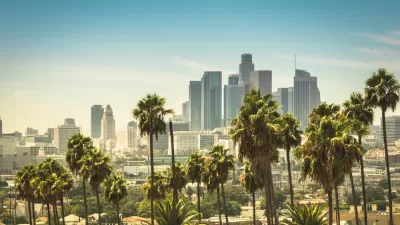Christopher Hawthorne completes his second installment in an ongoing series examining the transformation of Los Angeles through the lens of its famous boulevards. This entry focuses on the most famous street in the city - Sunset Boulevard.
Traversing Sunset "in the opposite direction", from west to east, Hawthorne explores the street's transformation as it points the way towards L.A.'s multimodal future. As he makes his way from the beach, and Sunset's famous gated enclaves on the west side of the city, towards the bustling nightlife of Hollywood and the eclectic street life of Boyle Heights, Hawthorne notes how the street provides (or fails to provide) a pedestrian-friendly environment.
Hawthorne describes the replacement of movie studios and entertainment-focused businesses with "hardier strains of L.A. architecture" along Sunset in Hollywood, as the city "tries to redefine itself for a denser and less car-dependent future." He also notes the newly opened Sunset Triangle Plaza, in Silver Lake, "A more nimble example of L.A.'s rekindled interest in street design and
the public sphere."
But what Hawthorne finds along Sunset (renamed Cesar E. Chavez Avenue) in the east L.A. neighborhood of Boyle Heights makes him most excited. "Shaded by huge ficus trees and crowded with pedestrians, the stretch of
Cesar Chavez just east of the 5 Freeway upends a few persistent
stereotypes about Los Angeles: that nobody walks, that everybody lives
in a single-family house, works in the movie business and spends most of
his time cocooned in an air-conditioned car, shouting Ari Gold-style
into his cellphone earpieces."
"Much of the street's success can be credited to neglect from the larger
city," writes Hawthorne, "as investment in the post-war era went elsewhere. But Cesar Chavez
Avenue hasn't just survived: It has emerged as a model for other
neighborhoods eager to make their major thoroughfares friendlier to
pedestrians, cyclists and local business. It has all the urban-design
amenities the average L.A. boulevard is desperately missing."
FULL STORY: For Sunset, a new dawn

Maui's Vacation Rental Debate Turns Ugly
Verbal attacks, misinformation campaigns and fistfights plague a high-stakes debate to convert thousands of vacation rentals into long-term housing.

Planetizen Federal Action Tracker
A weekly monitor of how Trump’s orders and actions are impacting planners and planning in America.

In Urban Planning, AI Prompting Could be the New Design Thinking
Creativity has long been key to great urban design. What if we see AI as our new creative partner?

King County Supportive Housing Program Offers Hope for Unhoused Residents
The county is taking a ‘Housing First’ approach that prioritizes getting people into housing, then offering wraparound supportive services.

Researchers Use AI to Get Clearer Picture of US Housing
Analysts are using artificial intelligence to supercharge their research by allowing them to comb through data faster. Though these AI tools can be error prone, they save time and housing researchers are optimistic about the future.

Making Shared Micromobility More Inclusive
Cities and shared mobility system operators can do more to include people with disabilities in planning and operations, per a new report.
Urban Design for Planners 1: Software Tools
This six-course series explores essential urban design concepts using open source software and equips planners with the tools they need to participate fully in the urban design process.
Planning for Universal Design
Learn the tools for implementing Universal Design in planning regulations.
planning NEXT
Appalachian Highlands Housing Partners
Gallatin County Department of Planning & Community Development
Mpact (founded as Rail~Volution)
City of Camden Redevelopment Agency
City of Astoria
City of Portland
City of Laramie





























